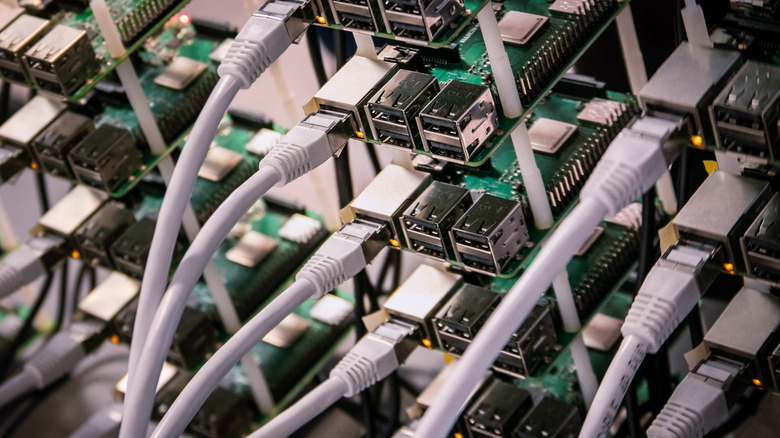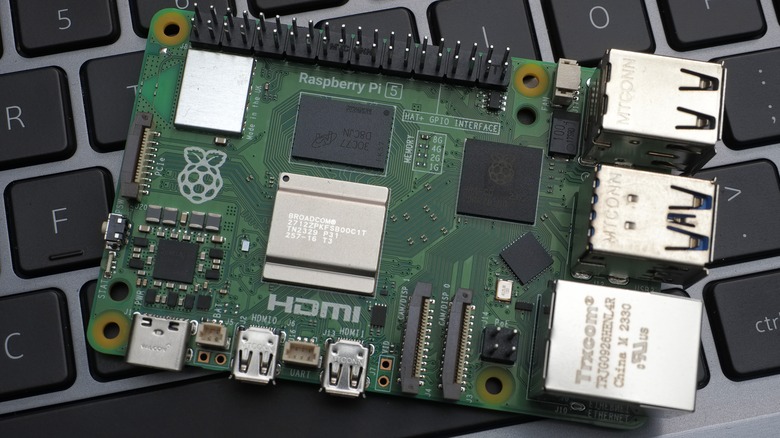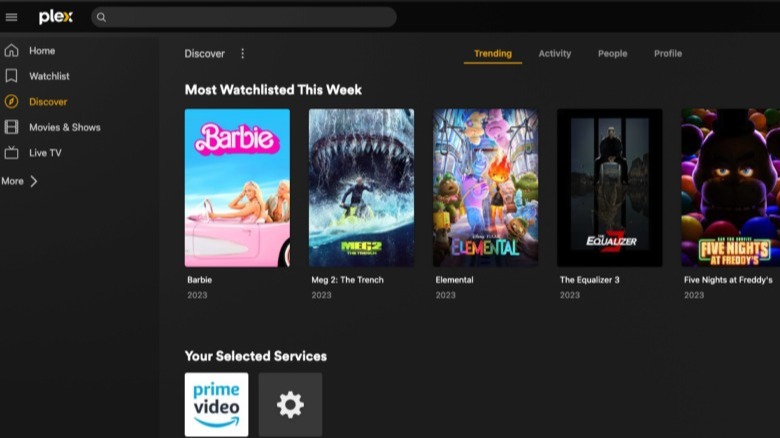6 Cool Uses For A Raspberry Pi Cluster
We may receive a commission on purchases made from links.
Several people in the maker space have made clusters using the miniature computers made by Raspberry Pi. The small form-factor PCs are immensely popular for these kinds of projects because they are compact, affordable, and relatively easy to work with. Raspberry Pi products are also supported by a massive community of developers that share open-source software. This allows Pi owners to use them in all kinds of projects without having to pay expensive licensing fees. Clusters are made when you connect two or more computers together so that they can be controlled together as if they were a single unit. The official Raspberry Pi website has step-by-step instructions that walk you through the process of putting one of these clusters together using its mini-PCs, but you might be wondering why you might want to build one and what kinds of tasks you would use it for.
The uses for a Raspberry Pi cluster are a bit eclectic. Attaching one PC to another doesn't automatically double the processing power or memory for single-task uses, but it does create a system that can handle a higher multi-task load than either individual computer would be able to perform on its own. It's particularly useful for expanding the capabilities of your home network. It isn't the kind of thing that most people would typically use a Raspberry Pi for, but it does open the door for some interesting applications.
Host your own private cloud
Cloud storage has become an integral part of modern tech, but it can be pricey and sometimes frustrating to deal with. A lot of people have also lost faith in the security of many of the big cloud services as hacks and data breaches have wreaked havoc, causing users' private information to be compromised.
Fortunately, there is an easy way for you to use a Raspberry Pi cluster in order to create your own private cloud system. Instructables and Pi My Life Up both offer in-depth instructions on how you can use a Raspberry Pi to create your own personal cloud storage network. The steps are a little different, but both methods are centered around the open-source cloud platform, ownCloud.
ownCloud is a cloud server software that allows you to share and synchronize data across multiple platforms while simultaneously keeping that data safe. It allows for global collaboration but also acts as a guard dog, monitoring and controlling who has access in order to prevent unwanted breaches. It's designed to marry connectivity tools that make it easy to store and access data across multiple devices with heightened security that helps keep your information safe from those who would seek to access it.
Host a personal web server
Are you interested in having your own website? Maybe you have a blog, own a small business, or need to maintain an online portfolio. Whatever the case, there are a few different ways that you can go about it. You can pay for an all-in-one service like Squarespace or split the hosting and develop services between two different companies like WordPress and Siteground. But you don't actually have to pay for a host at all. You can use a Raspberry Pi cluster to host your own personal web server. This will allow you to host multiple websites using your own hardware, so you don't need to pay other companies for the use of theirs.
There are a couple of different services that you can use to achieve this. Tom's Hardware has an excellent instructional that guides you through all of the steps to setting up a web server using the open-source HTTP server apache2 on your Raspberry Pi. Alternatively, you can make use of the Amazon Web Services applications, which offer a wide range of free and paid applications that you can use to host, support, and scale your website. AWS itself has a guide with step-by-step instructions for setting it up on a Raspberry Pi. Both methods work; it's just a question of whether you prefer the freedom of an open-source program or if you would like the security, scalability, and wide network of tools that come with Amazon.
Personal gaming server
Raspberry Pis aren't exactly high-end gaming computers, but they are surprisingly capable servers for networked gaming so long as the game itself isn't too demanding. Most modern games have public networks that allow you to play with your friends online, but there are advantages to having private networks as well. Stability and faster loading times are attractive benefits in certain retro games like "Quake" or "Doom," but there are other games where you can see much more extensive benefits. One of the best examples of this is "Minecraft." Setting up a private "Minecraft" server gives you full control of the game's configurations and allows you and your friends to build your own world together–one that is completely inaccessible from outside your network.
Electro Maker provides a guide for how to set this up on the Raspberry Pi. It requires you to set up a Debian-based Linux operating system and some tinkering in the console before you download the Minecraft: Java Edition server from the game's official website. It's ok if "Minecraft" isn't your jam though. There are also instructions for downloading a "Quake" and "Assault Cube" if you'd rather have a more traditional LAN party-style gaming session.
Manage your smart devices
Smart home automation is incredibly handy. It's grown progressively more popular as the technology that makes it possible has become cheaper and easier for manufacturers to produce. Automatic lights, smart thermostats, and self-brewing coffee pots have become common enough that we're no longer surprised to find them in the homes of our friends and neighbors. Smart home speakers, such as Amazon's Echo Dot or Google's Nest, are often used to manage these tasks. These are good enough for most smart homes so long as the owner pairs them with compatible off-the-shelf products, but they don't always work well with some of the more esoteric DIY automations that can be run by a Raspberry Pi.
If you're the kind of person who enjoys making their own automations or downloading open-source software from DIY developers, then you might be better off using a Raspberry Pi cluster to manage your automations in order to avoid compatibility issues. Smart platforms like Uber Home and Home Assistant can be run on a Pi and used to control your automations. Running them on a cluster adds the ability to manage a multitude of different automation tasks simultaneously without fear of encountering the same processing bottleneck that you would on a single-board system.
Create a file-sharing network
Another handy use for a Raspberry Pi cluster is to make a file-sharing network. Rather than uploading and downloading files to a shared cloud, this allows networked computers to share files directly, saving time, storage, and bandwidth. There are a few different methods for forging this connection using the Pi cluster. Samba is one of the better options. This is free software based on the SMB (Server Message Block) networking protocol that allows you to connect multiple computers by turning your Raspberry Pi into a NAS (Network-Attached Storage) unit. This offers lower operating costs and is arguably much more secure than using third-party services. Better still, Samba is compatible across all versions of DOS, Windows, OS, Linux, and several other platforms. This means that you will be able to share files across all of your devices even if you own both Mac and PC computers and are running a Linux-based OS on your Pi cluster.
Pi My Life Up has detailed instructions for how to turn your Raspberry Pi into a Samba server. All you need is your Raspberry Pi cluster with a hardline connection to your router and a sufficiently large, powered external hard drive. Then you can create a shared directory that all networked computers will be able to access.
Use it as a media server
Digital media has grown increasingly more prevalent over the years. Movies, TV shows, music, ebooks, audiobooks, comics, podcasts, and more can be stored as digital files that take up no physical space while offering equivalent quality to compact disks. These can take up quite a bit of your computer's storage, though, and constantly downloading, transferring, and deleting data from multiple devices can be a pain. A much better solution is to have a single networked media server that you can access from any connected device–and you can do just that with a Raspberry Pi Cluster.
There are a few programs out there that allow you to do this, such as Stremio and PlayOn, but the most popular option is probably Plex. It's easy to make and share a Plex streaming library, and you can easily set one up on your Raspberry Pi Cluster. You just need to download the Plex Media Server client app from the company's website for free and then set it up on your cluster to turn it into a server. You can do this with the regular Raspberry Pi OS, or you can deploy it with Docker. Then you just need a big enough external drive to store your media, and you can remotely stream it to any device with the login information any time you want!






